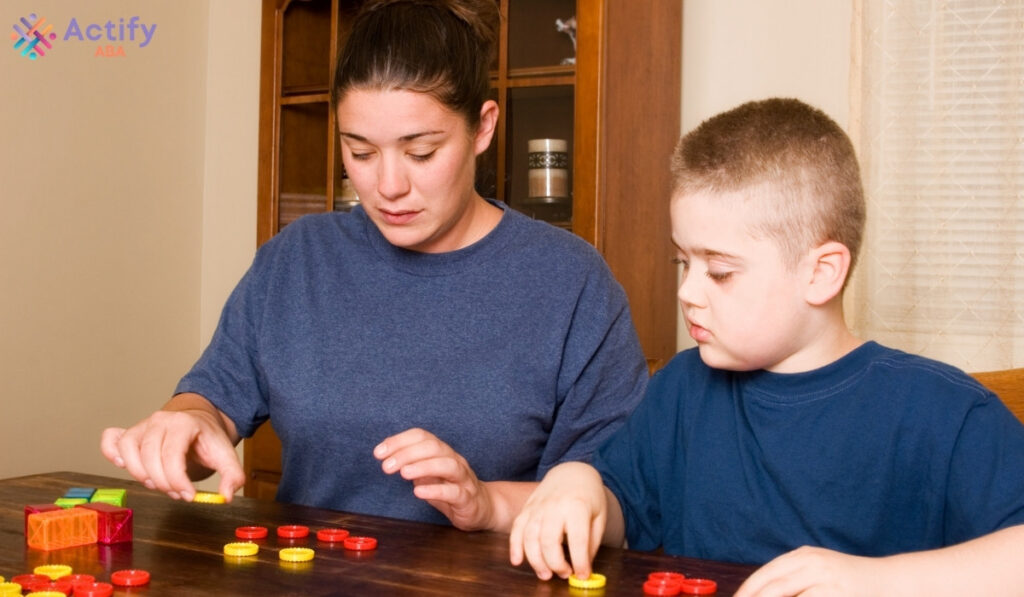
Key Points:
- In-home ABA therapy offers comfort and natural setting benefits, but may have more distractions.
- Clinic-based ABA provides structured routines and peer interaction opportunities.
- Choosing the right setting depends on your child’s needs, goals, and family routines.
Choosing between clinic-based and in-home ABA therapy services in Maryland can be one of the most important decisions you make for your child’s development. Both settings have unique advantages, and what works best will depend on your family’s needs, your child’s behaviors and learning style, and the logistics of your day-to-day life.
As ABA therapy providers in Maryland, like us at Actify ABA, we’ve seen firsthand how the right setting can make a big difference. In this article, we’ll break down everything you need to know—without fluff—so you can make a confident, informed decision.
Understanding the Basics: In-Home vs. Clinic-Based ABA
Before diving into pros and cons, it’s helpful to define what each approach looks like.
In-home ABA brings therapy into your everyday environment. Therapists work with your child at home, where behaviors naturally occur, making it easier to generalize new skills.
Clinic-based ABA takes place in a structured center environment. These spaces are designed specifically for learning and behavior intervention, often including tools, toys, and resources tailored to the therapy plan.
Both are rooted in the same principles of Applied Behavior Analysis—but the delivery looks different, and that difference can have a big impact.
The Benefits of In-Home ABA Therapy
In-home ABA offers familiarity and natural context, especially beneficial for younger children or those who experience anxiety in new environments.
Here’s why many families in Maryland choose in-home ABA:
1. Familiar Environment
Your child learns and practices skills in the same environment where they’ll be used.
- Activities like brushing teeth, asking for help, or following routines are easier to practice at home.
- It reduces the need for skill generalization from clinic to home, because therapy is already happening at home.
2. Family Involvement
Parents and caregivers get to observe and participate more actively in sessions.
- You can learn the same techniques the therapist uses and apply them throughout the day.
- It’s easier to build consistency across all caregivers.
3. Flexible Scheduling
In-home services can often fit more naturally into your existing family routine.
- No commuting or managing transportation.
- Therapy can take place before or after school, around mealtimes, or during sibling nap times.
The Benefits of Clinic-Based ABA Therapy
For some children and families, the structured setting of a clinic is more beneficial. It allows for focused work and access to a wide range of therapeutic tools.
Here’s why clinic-based ABA can be a strong fit:
1. Structured and Controlled Environment
Clinics are designed to support learning and minimize unnecessary distractions.
- Sessions follow a routine, which can help with behavior regulation.
- Therapists can create intentional challenges in a controlled space to help your child build coping strategies.
2. Opportunities for Peer Interaction
Clinic settings often allow for interaction with other children.
- Your child can practice social skills like turn-taking, sharing, and waiting in line with peers.
- Small group activities are often part of the program.
3. Access to More Resources
Clinics are usually stocked with teaching materials, sensory tools, and reinforcement systems.
- Your child may benefit from tools or structured areas that aren’t practical to replicate at home.
- Therapists can quickly adapt and access different resources to meet your child’s changing needs.

How to Decide What’s Right for Your Child
There’s no universal answer—but there are some key considerations that can help guide your decision. Below are several questions to ask yourself before choosing between clinic-based and in-home ABA in Maryland.
1. Where Does Your Child Struggle Most?
If your child struggles primarily with daily routines like mealtime, toileting, or transitions at home, in-home therapy may offer faster progress.
But if your child has difficulties with group settings, waiting their turn, or following structured tasks, a clinic setting can simulate and practice these scenarios.
2. How Easily Is Your Child Distracted?
Some children thrive at home, but others are easily thrown off by pets, TVs, or siblings.
If your child struggles to stay focused, the more controlled environment of a clinic could provide fewer interruptions and more learning time.
3. How Comfortable Is Your Child in New Environments?
If your child has separation anxiety or gets overwhelmed in new places, starting with in-home ABA might reduce stress and support gradual adjustment.
Conversely, if they are easily bored or unmotivated at home, the novelty and stimulation of a clinic setting could help them stay engaged.
4. What’s Realistic for Your Family?
Transportation, work schedules, and home space all play a role.
- If you’re managing multiple children or tight schedules, in-home ABA might save you time.
- If your home is small, noisy, or chaotic, a clinic may offer a more effective therapy setting.
Pros and Cons at a Glance
If you’re still weighing your options, here’s a side-by-side summary:
| Factor | In-Home ABA | Clinic-Based ABA |
| Environment | Familiar, natural context | Structured, focused setting |
| Skill Generalization | Immediate, natural | May require additional support |
| Parent Involvement | High involvement | Moderate involvement |
| Peer Interaction | Limited | Frequent and structured |
| Therapist Tools | Limited to what’s at home | Full range of clinic resources |
| Distractions | Can be high | Typically low |
| Logistics | No commute, flexible | May require transportation |
Combining Both Approaches: Is It Possible?
Yes—and in some cases, it’s ideal.
Some families start with one approach and then transition as the child progresses. Others do a hybrid model, combining both settings to address different goals. For example:
- In-home therapy can focus on morning and bedtime routines.
- Clinic-based sessions can target communication or socialization skills.
At Actify ABA, we help families explore the benefits of both models and can guide you in creating a balanced therapy plan that evolves with your child.

How We Help Families in Maryland Decide
When families reach out to us at Actify ABA, they often feel unsure which path to take. Our job is to listen, assess, and guide you through that choice based on:
- Your child’s developmental goals
- Behavioral assessments and learning history
- Your family’s daily rhythm, bandwidth, and availability
We understand that ABA therapy is a big commitment—not just in time, but emotionally. That’s why we emphasize transparency and collaboration every step of the way. Whether you start with in-home services or clinic-based support, the goal is the same: meaningful progress in your child’s life.
The Bottom Line: Choose the Setting That Serves Your Child Best
Deciding between clinic-based or in-home ABA in Maryland isn’t about which setting is “better”—it’s about what works for your child and your family. Think about where your child will feel safe, engaged, and ready to learn. Think about what your family can realistically support week to week. And most importantly, stay open to adjusting the plan over time.
Get in touch today to learn more about our ABA therapy in Maryland and how we can help you choose the setting that fits your family best. We’ll walk you through your options, talk honestly about what to expect, and help you take the next step toward progress that lasts.
